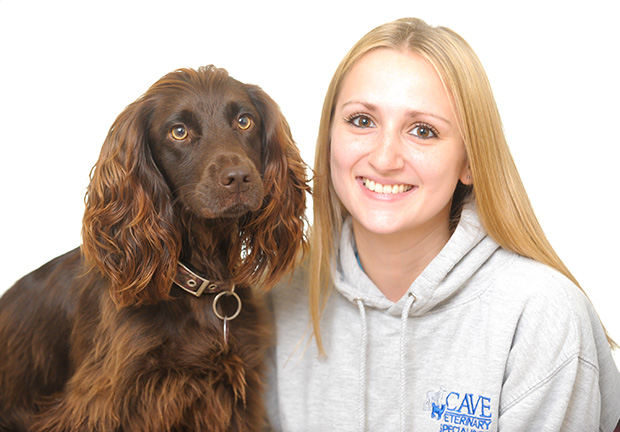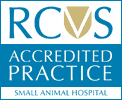Sophie is a Medicine/Wards nurse here at Cave and helps runs our chemotherapy clinics. She graduated from Hartpury College in 2016 with a Foundation Degree in Veterinary Nursing. After a 60-week placement with another referral centre she came to Cave Veterinary Specialists to further her nursing skills and continue to work in referrals.

Why did you choose to specialise in Chemo treatment?
I like having a particular area of medicine to focus on and feel confident with. It’s satisfying getting to know the patients and meeting their families. They get to know us too. It is nice at the end when the treatment has completed and we get to give a certificate to the pet.
What challenges do you typically face?
As I’m sure all vets and nurses find, nervous or anxious patients can be a lot more challenging. We try to make the experience as positive as possible. Cats have smaller veins and are generally less likely to be placid. Some pets need a light sedative before they attend a session to help.
What happens during a typical chemotherapy session?
When the patient arrives in the waiting room, they are booked in and weighed. The chemo nurse will take them through to the suite to have blood taken. It is important to take a blood sample before treatment because if the white blood cell count is too low, it is not safe to continue. Some tests are run in our lab on site and some are sent to an external lab.
The owners will have a consultation with the vet. The vet will examine the patient then hand over the patient to the chemo nurses with instructions about the dosage and treatment. The chemo will be drawn up in the biological safety cabinet and equipment prepared. The patient will be positioned for the IV and treatment, this usually requires 2 people because it is essential that the patient stays very still. They are made to feel as comfortable as possible because IV treatment can take between 5 and 20 minutes. Some chemo sessions involve oral administration. This is given in cocktail sausages or ham which many dogs view as a treat. It is common to give both kinds of treatment on different visits depending on the treatment plan.
After treatment, the patient returns to their family and we discuss home care, cytotoxic safety and answer any further questions. We have some safety information that is also issued with the relevant treatments.
How do you protect yourself?
Chemotherapy drugs are cytotoxic and kill living cells so it is important to stay protected. We use our PPE (Personal Protection Equipment), the gowns are certified for use with cytotoxic materials as are the special purple chemo gloves and eye protection that we wear. We also use a closed drug transfer system called phaseal, which prevents the environmental release of hazardous drugs into the environment, protecting us and the owners. A ‘do not disturb sign’ is displayed on the door when a patient is receiving treatment.
And what about outside of work?
I have a 2 year old spaniel called Hurley who needs plenty of exercise! We’ve recently taken up agility which is great fun and keeps both of us fit.
PhaSeal
Cave Veterinary Specialists is a UK supplier of PhaSeal® products, we provide specialist chemotherapy administration equipment to other practices. We act as a distributor as well as giving advice.




